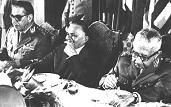#22
Mensagem
por Einsamkeit » Ter Mai 08, 2007 2:49 pm
Japan fired up over US fighter
By David Isenberg
The US government has officially acknowledged that it intends to sell an advanced fighter to Japan. The smart money says it will be the F-22 Raptor, a stealth air-superiority fighter.
The F-22 is considered the most advanced air-superiority fighter in the world. Built by Lockheed Martin, it is equipped with electronically scanned array radar for cruise-missile detection, has wide-band data links, and is capable of evading advanced air defenses to bomb ballistic-missile launch sites. Its operational radius extends as far as 2,000 kilometers. The F-22 can also operate about 5km higher (at 65,000 feet, or 19,800 meters) than other fighters.
The aircraft goes for US$136 million each, not including development costs. But some news reports say Japan would be willing to pay $300 million each for a fleet of 100 jets.
Aviation Week & Space Technology reports that Japan will also carry the cost of integrating an anti-tamper kit on key technologies, including hardware and software, on the F-22. Estimates range from $600 million to $1.2 billion for the cost of doing this.
Key software that would be protected, for example, manipulates and integrates the advanced, cruise-missile-detecting radar and long-range electronic-surveillance array, as well as the aircraft's other target detection and analysis sensors. Exporting the technology isn't a concern for US combat pilots, since software packages for US versions of the aircraft will always contain extra capabilities.
Last June, during a US military training exercise, the F-22A achieved a 144-0 kill-to-loss ratio against F-15s, F-16s and F/A-18s, which outnumbered the F-22A by about 4-1 during the exercises.
If Japan obtains up to 100 F-22s, it will have the world's second-biggest air force and dominate the skies over the Korean Peninsula and China. Officials claim Japan needs the fighter available to defend against the Chinese Su-27 and Su-30s. Media reports say the Japanese are firmly committed to acquiring the F-22 to complement their recently acquired airborne defense platforms, including KC-767 airborne refueling tankers and E-767 AWACS (Airborne Warning and Control System) aircraft.
Japanese Defense Minister Fumio Kyuma has already requested more information from the Pentagon on the F-22 to study the capabilities of the aircraft and begin serious dialogue for a potential purchase.
Dennis Wilder, senior director for East Asian Affairs on the US National Security Council staff, confirmed a future deal one day before Japanese Prime Minister Shinzo Abe visited the United States last month. In response to a reporter's question, Wilder said:
In terms of future fighters for Japan, obviously, the Japanese air force has requirements. China is modernizing, at a rapid pace, its air force. The Japanese obviously feel some threat in relation to North Korea and its development of missile and nuclear capabilities. And so we are very positively disposed to talking to the Japanese about future-generation fighter aircraft.
One sign that the deal with the F-22s will go ahead is that Japan and the United States recently conducted joint air force drills involving a squadron of F-22 stealth fighters temporarily deployed at Kadena Air Base in Okinawa.
Although US law forbids the export of the F-22, with a few exceptions, to protect its technology, Congress seems ready to change the law to lift the ban, and the administration already has expressed willingness to negotiate with Tokyo over their sale.
Lockheed Martin Corp and its F-22 partners - Boeing Co and United Technologies Corp's Pratt & Whitney unit - would, of course, love to sell the planes to other countries, because greater production numbers would lower costs and raise profits. This is because domestically, US law limits the planes to just one customer - the US Air Force (USAF).
Also, overseas sales could extend the production line beyond 2011, when the last of the 183 Raptors currently planned is due to be sent to the USAF.
Still, the sale is not a foregone conclusion. Reuters reported that USAF Lieutenant-General Jeffrey Kohler, head of the Pentagon's Defense Security Cooperation Agency, which coordinates government-to-government weapons sales overseas, said that designing an export version of the F-22 could cost more than $1 billion and be "prohibitively expensive" for any would-be foreign buyer.
"If [export] were to be considered ... it essentially would have to be redesigned, rebuilt, retested and then go into production." He said the US intent is to supply Lockheed Martin's next-generation stealthy F-35 Joint Strike Fighter, due to be available for export in about 2015.
If the US government does allow the export of F-22 stealth fighters to Japan, it will be seen as an indication that Washington has made up its mind to strengthen the US-Japan alliance as part of its security strategy in the Northeast Asian region.
Some Japanese think that the US should sell the F-22 because Japan provides the US forward bases in the region as well as dispersal and rapid-deployment options in case of a military confrontation or natural disaster, say US officials.
Israel will also be watching the possible sale quite closely as it has shown keen interest in acquiring the F-22.
Acquisition of the F-22A would also be consistent with Abe's vision of Japan's foreign policy. During a March 18 speech at the National Defense Academy of Japan, Abe reiterated his call for the country to adopt a more assertive foreign policy and improve military capabilities. He called for further strengthening of the "Japan-US alliance while steadily upgrading our country's national-security platform".
Over the past two years, the US and Japan have accelerated cooperation in ballistic-missile defense, with Japan procuring PAC-3 (Patriot Advanced Capability 3) batteries and the naval Standard Missile SM-3 air-defense systems. Additionally, Tokyo has acquired upgraded EP-3 patrol aircraft, radar and other facilities related to C4ISR (command, control, communications, computers, intelligence, surveillance and reconnaissance).
In terms of regional reaction, some countries have expressed concern. South Korea has hinted it will also seek to procure the F-22 to cope with any possible security jitters. Defense Minister Kim Jang-soo hinted that his country will review its plan to buy F-15 aircraft and seek the more advanced F-22 models. Under a 2002 deal, South Korea is now procuring 40 F-15 jets from US aerospace giant Boeing and is expected to purchase 20 more F-15 jets to replace its aging fleet of F-4 Phantom IIs.
Meanwhile, China has already started developing its own advanced stealth fighters, Jian-13 and Jian-14, to match the F-22s. In response, Taiwan plans to acquire 60 F-16 C/Ds from the US to upgrade its preparedness.
David Isenberg is a senior research analyst at the British American Security Information Council, a member of the Coalition for a Realistic Foreign Policy, a research fellow at the Independent Institute, and an adviser to the Straus Military Reform Project of the Center for Defense Information, Washington. These views are his own.
(Copyright 2007 Asia Times Online Ltd. All rights reserved. Please contact us about sales, syndication and republishing.)
Somos memórias de lobos que rasgam a pele
Lobos que foram homens e o tornarão a ser
ou talvez memórias de homens.
que insistem em não rasgar a pele
Homens que procuram ser lobos
mas que jamais o tornarão a ser...
Moonspell - Full Moon Madness













